|
|
|
there's a limit
Thursday, December 26 2019
location: room 112, Phool Mahal Palace, Kishangarh City, Rajasthan, India
Up until this morning, our days had been cool and foggy, with temperatures reluctant to rise into the 60s. This had made things a bit uncomfortable for us gringos, since many of the places we'd been staying had no (or very ad hoc) means of heating. But here on the lake in Kishangarh, the day began without fog and the sky stayed cloudless all day. After breakfast, we all went to a grassy field in the Phool Mahal grounds to learn and then "play" cricket. This was part of our exposure to Indian culture, with cricket being one of the most important contributions made by the British. The rules were all explained, though none of it really mattered, because when we went to play, it ended up being just the two people at the opposing wickets (which were not spaced apart the full regulation 60 meters or whatever it is) versus the the rest of us, who spread out all over the field to catch or otherwise retrieve any balls batted by whoever was up at the wickets. Instead of using a regulation cricket ball, which can be painful if hit by one, we used a tennis ball. But the bats were actual cricket bats, which seem unnecessarily wide to someone familiar with American baseball. This meant, however, that, when it came my turn at bat, I could reliably hit the balls thrown at me. Unlike in American baseball, it's perfectly normal for a pitcher (in this case, always one of the locals) to bounce the ball off the ground on the way to the batter. Oddly, once the batter hits the ball, he then carries the bat as he runs. Because Gretchen's foot was bothering her, she sat on the sidelines and didn't participate except to yell goofy words of encouragement to whomever was at bat. It was her father's birthday, so she yelled about that when he was at bat. And when I was at bat she yelled things like, "That's my maaaayan!" She later told me she was having such fun that she felt like she was on some opioid.
Later the 22 of us got an exclusive tour of the adjacent castle. On the walk over there, we went down busy streets, passing a number of pigs and encountering a tiny puppy who looked like he or she might be a pit bull. Gretchen picked it up to kiss it, and we wondered briefly where its mother might be.
The gates to the castle were massive and featured an array of spikes starting about seven feet above the ground. I suspected this might have something to do with thwarting elephant-based attacks, a suspicion confirmed later when I learned these were called "elephant spikes." The castle, which dated to the 1600s or so, featured numerous details such as cantilevered gables and windows covered with stone screens, each featuring arrays of holes in various decorative shapes. Underneath some of the overhanging structures were the occasional open-air honeycomb, which usually took the form of a single slab of bee-covered wax that could be as much as four square feet on a side. Evidently in warm climates such as India's bees feel no particular need to put their nests in the hollows of trees, choosing to place them in high, inaccessible places protected from the rain. As for the rest of the castle, it consisted of a warren of mostly small rooms and courtyards connected seemingly at random. Here and there would be a pocket of decor or a place where handy photos showed the place had played a rich history in the context of the kingdom which the castle was built to defend. Mostly, though, the castle was in a state of world-weary decay. One had to be careful not to lean on railings for fear they would collapse and send you plummeting to your death.
Back at Phool Mahal, we were all told to sit in chairs in the shaded outdoor area on the shore of the lake to await the arrival of "the king." The ancient kingdom of Kishangarh still has, we were told, a maharaja, though he's been stripped of all his power and tax advantages. However, he still retains ownership of his ancestral castle, as well as the Phool Mahal just outside of it. In order to maintain these properties, he is forced to operate them as hotels, which was the reason we were there.
The king arrived with understate fanfair, more like the kind that would greet a mafia don than a member of a royal house. He was a stocky man wearing sunglasses and a nice watch, and he took a seat with his back to the lake. He then told us about the ancient history of his kingdom, ending with the story of how the government of India gradually wound down his grandfather's and father's authority. Unlike all the other Indians who'd been talking to us on this tour, the king's English was flawless and easy to follow. Clearly he'd attended university in the United Kingdom.
Lunch in the banquet hall was the first disappointing meal of the voyage. It lacked a boldness of flavor that I'd come to expect from real Indian food (and I don't just mean that it lacked heat, though that was also a problem). This had me worrying that perhaps the cooks at this palace might be tempering things out of concern for what they think Americans would prefer to eat.
The afternoon activity was to go into the new part of Kishangarh to buy pens and other school supplies to later hand-deliver to children at a local school. I had a feeling I wouldn't want to be doing that, so I skipped out on that activity. Instead I went up on the roof with my work-issued laptop and went through some of the pictures I'd been taking and also did some of the writing that you, as a reader, then read. Part of the reason for being on the roof was to get out of the palatial room we'd been assigned, since its marble surfaces retained much of the winter chill. But I also needed to be outside (either in the courtyard near the banquet hall or on the roof nearby) to be within the range of Phool Mahal's WiFi signal.
Usually when Gretchen and I travel, our rooms come equipped with a way to heat water as well as a way to make not-completely terrible coffee. In India, though, the best coffee one can expect in one's room is Nescafe, as if it is still 1987. At these palaces, though, it's common not even to get a means to heat water. This afternoon, I was so desperate for a cup of coffee that I was willing to purchase a cup of "double Nescafe" from the "bartender" in the banquet hall. (I didn't know this was an option until I saw Kirstin with a cup of Nescafe.) [Later, though, Veg Voyages would cover the costs of all such non-meal teas and coffees.]
After Gretchen and the others got back from their school-supply-buying run, she told me about an embarrassing incident that had happened while they were out. Apparently Gretchen came upon an adorable street puppy and immediately went to pet it or pick it up (or whatever she ended up doing). When her father saw her doing that, he flipped out and shouted "NO!" and then "THERE'S A LIMIT!" Evidently that was something he used to shout at her when she misbehaved as a little girl. Evidently he was concerned that the puppy might be carrying a disease (such as rabies). As he later pointed out (calmy but also correctly) had Gretchen been bitten by that puppy, it would have to be euthanized and she'd have to undergo an unpleasant series of rabies shots. Gretchen thinks her father was being infantilizing and overly cautious, and that she knows how to avoid being bitten by a puppy. From my perspective, I think her father was probably overreacting, but I also think Gretchen takes unnecessary risks with unknown animals (and other dangerous things). There's no way she can be so sure how a puppy, particularly one she awakens from slumber with a pet on the head, will react.
This evening, before sunset, our group walked through the bustling streets of Old Town Kishangarh past the cows, dogs, pigs, motorbikes, and many dozens of tiny shops selling mysterious goods and services until we reached a tiny little Hindu temple, which was just about to start services. We took off our shoes and went into the small windowless concrete-floored worship area. It was dreary place that smelled faintly of cat piss. In the back of the space, almost like a teller at a bank, was the priest, who stood with the main idol (aka "god") in a specially-lit room full of incense. Unlike most Indians, the priest was a tall man with an impressive pot belly and a mane of long grey hair. His assistant, a skinny teenage boy, hit a button on a device that began the automated ringing of bells that began the ceremony, which involved the priest doing various things with the idol (who reminded me vaguely of the Big Boy burger mascot). The priest then showed us an album of photos from the temple and said a few things to us in Hindi, which our fixer J translated. None of it seemed particularly profound or transcendent, but we acted respectful, accepting the ritual gestures in turn and then, as we left, not turning our back to the idol.
Since our rooms in the palace hadn't been designed with bathrooms in mind, the plumbing was minimal. To get hot water for the shower, each room was equipped with something called a "geyser" (which our guides referred to as a "geezer"). The geyser consisted of a several-gallon tank that was heated with electricity. Yesterday, we'd all discovered that the geysers could only produce hot water for a couple minutes before being exhausted. Today, though, I found that if I dialed down the flow of water leaving the geyser, I could have a shower lasting as long as I wanted (though surely THERE'S A LIMIT).
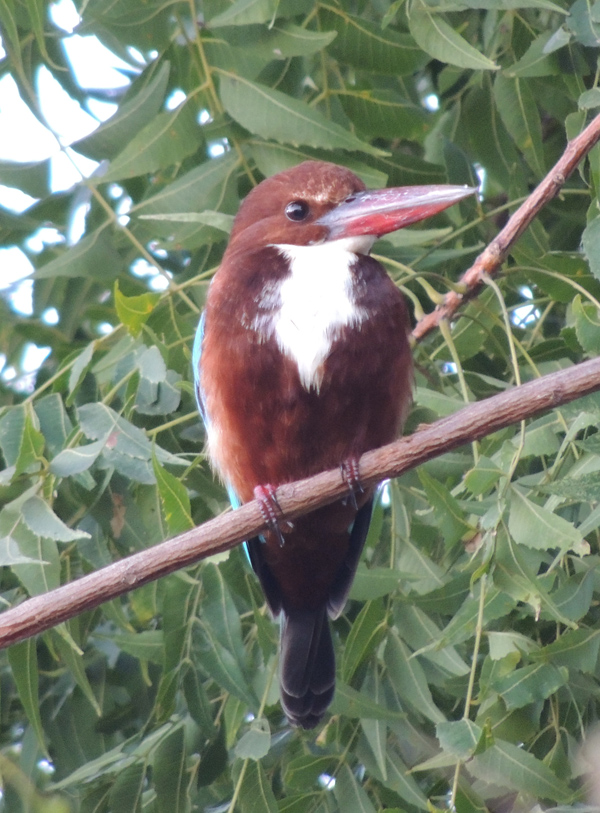
A white-throated kingfisher in a neem tree near the palace. Kirstin's mother Connie, who is into essential oils, crystals, and that sort of thing was excited about neem trees. Click to enlarge.
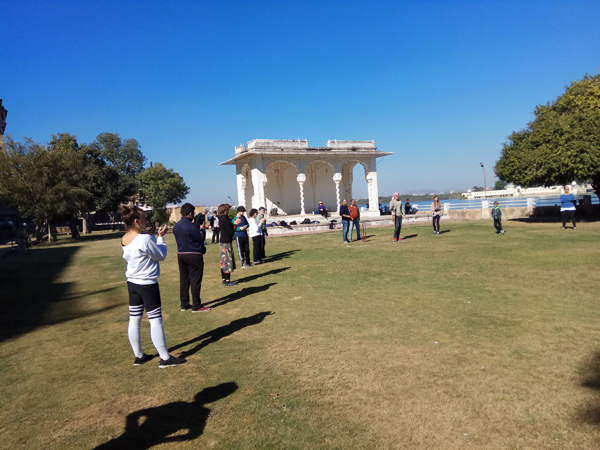
Today's cricket game, looking south (check out the exquisite columns on that little building). Click to enlarge.
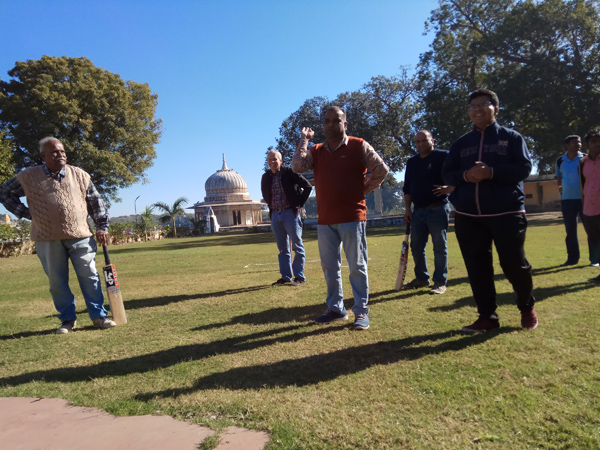
Today's cricket game, looking north. From right, it's all staff: Singjih, Zack, J, J's brother, CC, the bus driver, and his assistant. Click to enlarge.
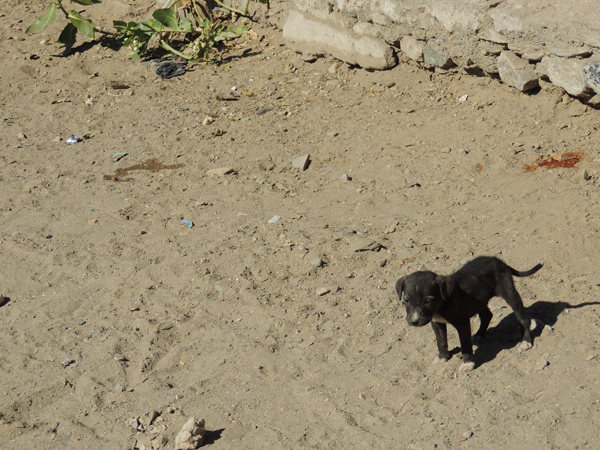
The first puppy we saw this morning on the walk to the Kishangarh castle.
Click to enlarge.
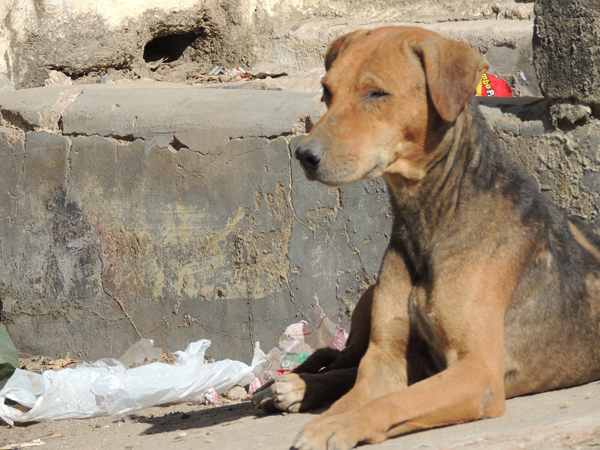
A street dog near the Kishangarh castle. Click to enlarge.
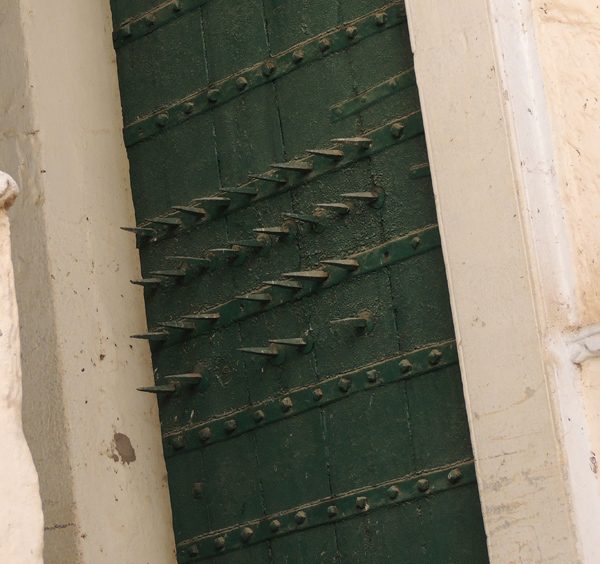
Elephant spikes high on the door of the Kishangarh castle.
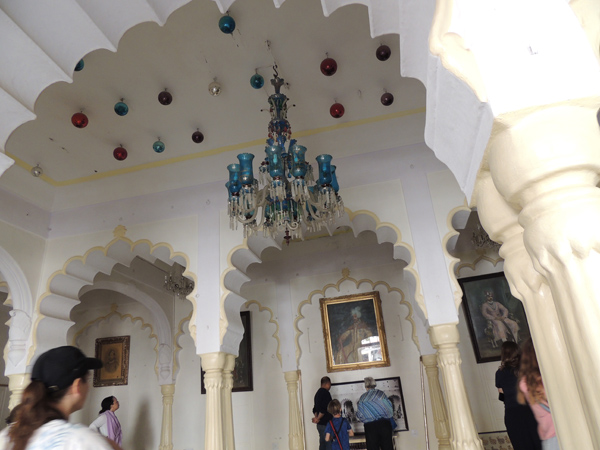
A fancy room in the Kishangarh castle.
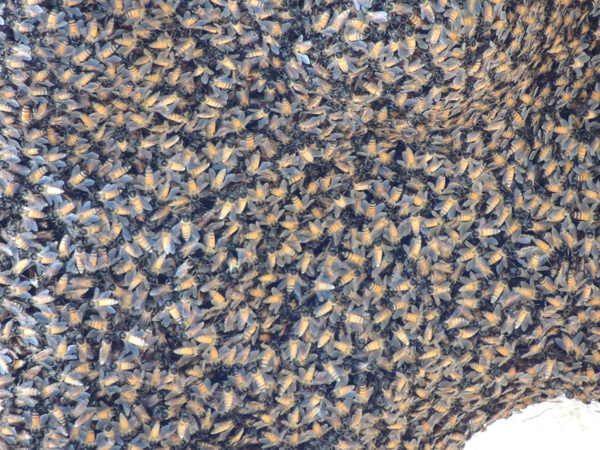
Close up of an open-air honeycomb in the Kishangarh castle. Click to enlarge.
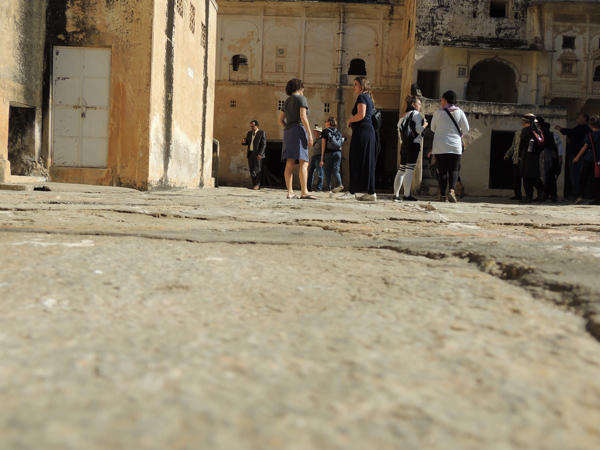
A courtyard inside the castle. That's Gretchen in the skort, talking to
Kirstin. She later added trousers to this ensemble in an attempt to achieve India-appropriate modesty.
Click to enlarge.
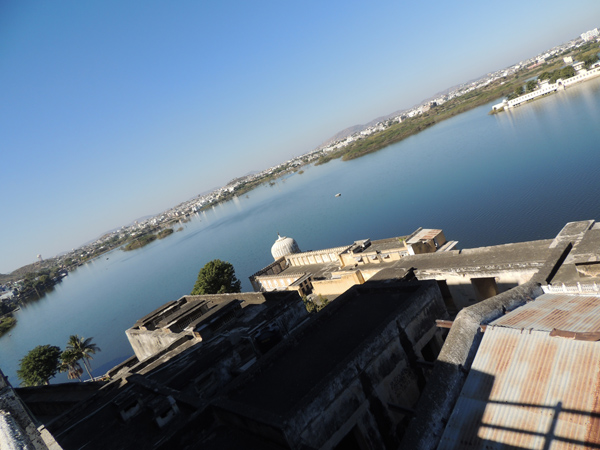
The Phool Mahal from the Castle, with the lake beyond. Click to enlarge.
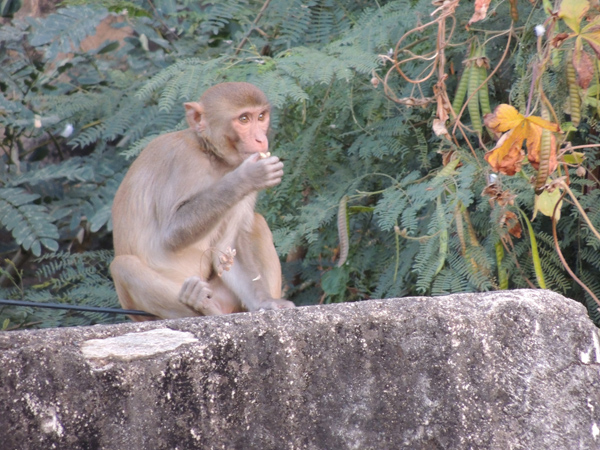
A rhesus monkey near the base of the Kishangarh castle. Click to enlarge.
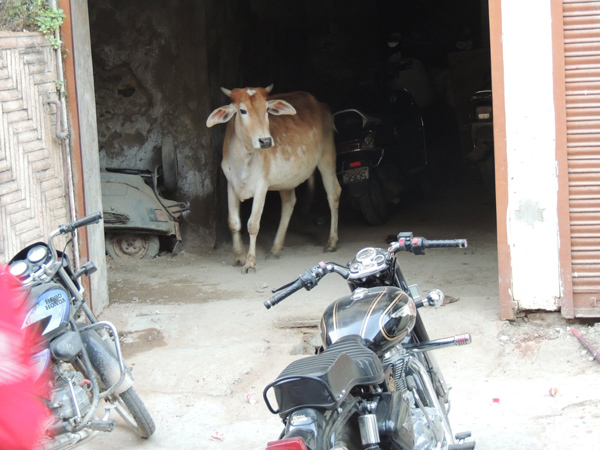
\
A cow in a garage on our walk to the small Hindu temple. Click to enlarge.
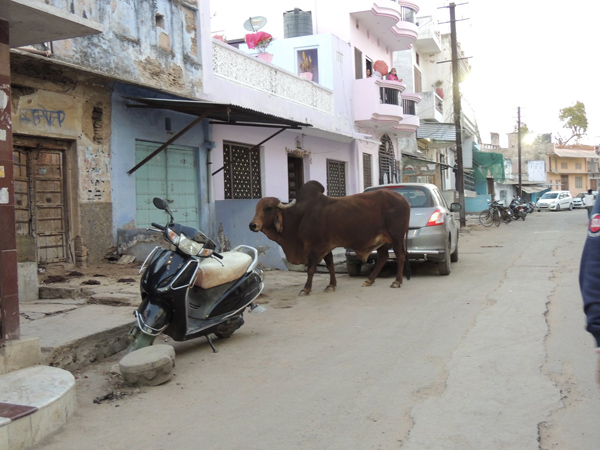
A bull amid vehicles on our walk to the small Hindu temple. Click to enlarge.
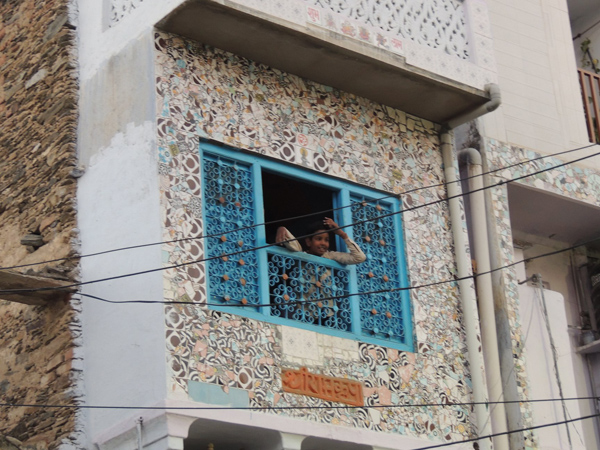
A fancy window on our walk to the small Hindu temple. Click to enlarge.
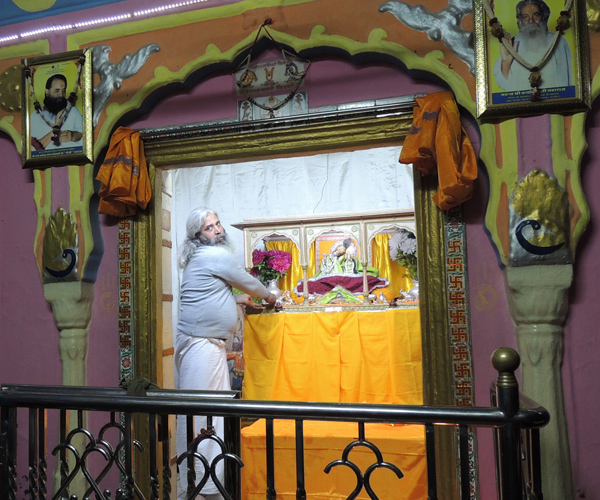
The priest in his sacred booth at the small Hindu temple in Kishangarh. Note the swastiks, which we'd all been briefed about in the lecture two nights ago.
Click to enlarge.
For linking purposes this article's URL is:
http://asecular.com/blog.php?191226 feedback
previous | next |














